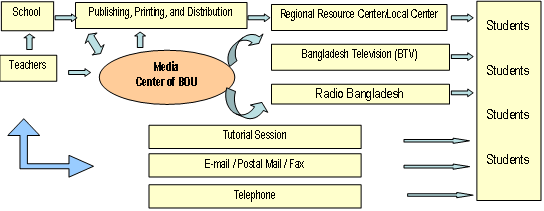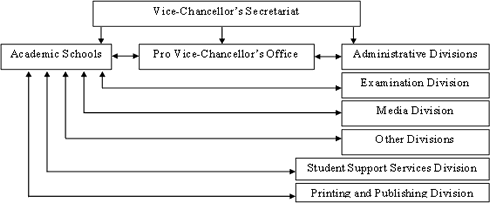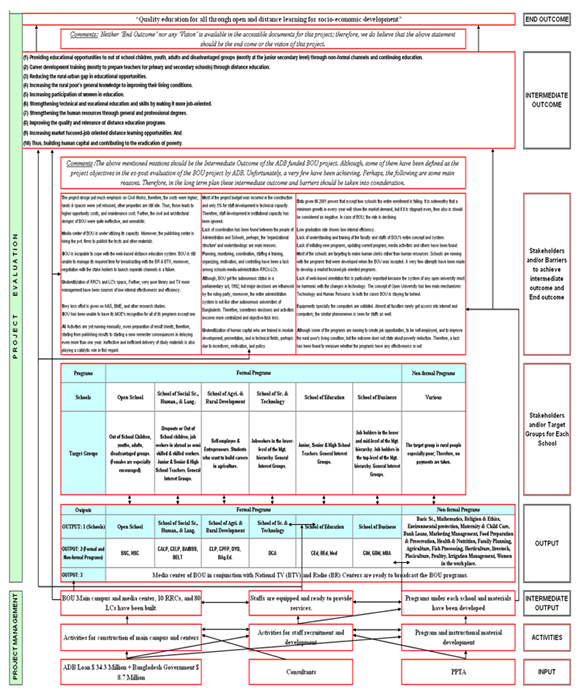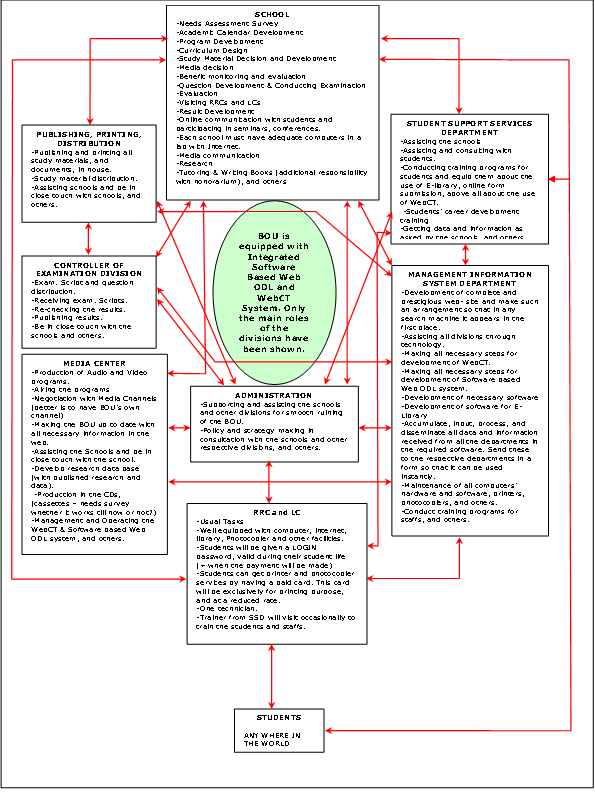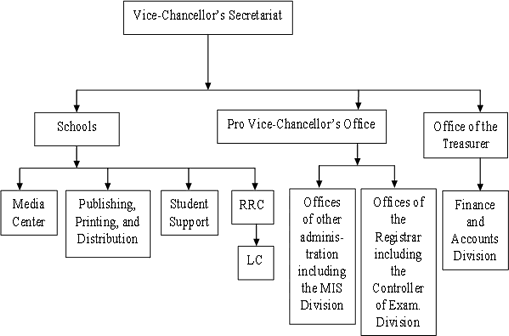|
Bangladesh Open University: An Evaluation Md. Parves Sultan, Bangladesh Open University Abstract
INTRODUCTION An open university is an institution for distance education. It is designed for those who intend to improve the level of their education or professional skills by studying at home or at places of their work. It meets the need for education of all classes of people particularly those who are deprived of education from conventional institutions. An open university offers a wide variety of formal and non-formal programs through printed materials, web-based system and/or electronic media like radio, television, audio and video cassettes, CDs, telecommunication and tutorial services. The concept of distance teaching became popular as early as in the sixties and by now many countries in the world have established open universities. However, distance education in Bangladesh started since 1956 with a distribution of 200 radio receivers. Open and distance learning (ODL) get institutional status through establishing the Bangladesh Open University (BOU) and it receives the autonomous status by the parliamentary act, 1992. With a population of nearly 140 million, Bangladesh faces the challenges of creating manpower within the shortest possible time. Available educational facilities in the country are inadequate to meet this challenge. Access to education is always limited by physical facilities in the conventional system. Therefore, the objectives have been clarified in the BOU act [BOU Act-1992, No-38, 3(5)] as to create educated and trained work-force by providing access to a wide range of educational and vocational training programs for all levels of people particularly for disadvantaged and rural masses including women who are generally deprived of formal education and training. The Government of Bangladesh and the Asian Development Bank (ADB) have provided funds for setting up the University. The main structure of the University has been built as the central campus at Gazipur, about 40 kilometers north of Dhaka-the capital city of Bangladesh. The Open University is a breakthrough to grab the chance and to pursue the objectives to enrich knowledge of people, especially in developing countries. Most of the people in developing countries and Least Developed Countries do not have access to sufficient education. The condition also become worst when improvement and recovery of the economy are the main priorities of government's policy instead of education. In this situation, Open University is relevant. More and less, developing countries have similar problems in education. Many alternatives of solution have been developed to overcome the problem. Large number of out of school children, disadvantage groups, skilled and unskilled working class, rural people, job seekers and women who couldn't afford to have regular education; the open and distance learning (ODL) system has given them an open door access. Therefore, the concept of Open University is popular in all nations. The following figure illustrates BOU's operation:
This paper evaluates the Open and Distance learning activities of BOU and finds out the problems and recommendations for effective dissemination of programs.
LITERATURE REVIEW The available literature found for this study fall into two main groups. First group focuses on specific programs, target segments and methods of delivery of open and distance learning systems. Second group focuses the ex-post evaluation of the BOU project conducted by the ADB. Kamal et. al. (2005) point out frequency of teacher-student interaction, inadequate email and post mail communication, inadequate Radio and TV programs, lack of proper time for broadcasting these programs are some of the drawbacks of BOU's programs. They put importance of having a smart information transfer system for BOU that can be accessed from any where of the world, need of separate broadcasting channels, and online delivery of study materials. Karim and Afrin (2004) find in their survey research that students are dissatisfied with the counseling and media programs of BOU. They point out the necessity of library and computer facilities at the regional and local centers. Karim and Ahmmod (2003) state the importance of increasing the frequency of broadcasting the BOU programs, narrating the learning goals, objectives, procedures, and philosophy to various stakeholders. They also point out the problems of delivering the materials to students, promotional activities, assessment procedure, publishing results in due time, and maintaining the academic calendar. Kamal and Sultana (2002) state that most of the programs of BOU are suffering from very low rate of students' enrolment since after a few years of BOU's inception. To further strengthen the programs, they underline the importance of using media center both in digital and online communication, identifying the needs of the programs from the view point of the students, and timely production and delivery of study materials. They also find out some problems regarding coordination among divisions, existence of different associations between academics and officers, infrequent meeting, internal and external lobbying for up-gradation of staffs' posts. The researchers also put emphasis on the development of ICT. They also state that most of the key positions at BOU are occupied by the persons come from conventional institutions. Therefore, a tendency toward conventionalization of the ODL system is being noticed sometimes. However, Sultana and Kamal (2002) put emphasis on online delivery of study materials and organizational structure of BOU. They state that the management structure of BOU is not synchronous as they are horizontally integrated with the vice-chancellor's secretariat and for this, various management problems occur between schools and administrative divisions. The researchers show the following organizational structure that has been practicing in the BOU.
Source: Sultana and Kamal (2002) The researchers also state that Academic Schools and at least three divisions such as Student Support Services Division, Printing and Publishing Division and Examination Division should have strong coordination among them. Umeda and Unetani (2002), Nagamatsu (2002), Berwick (2002), and Hara (2002) have emphasized on the WebCT (web-based course tool), and online delivery of course materials. Gamlin (2002) states that WebCT is ideally suited for on-line teaching and learning as well as research. Through WebCT, instructors are able to create an on-line learning environment that maximizes students' interactions with the content materials, the peer group and the course instructor. In addition to using E-mail, chat-rooms, bulletin board the WebCT also delivers the course materials, instructions, and facilitates the submission of assignments by the students. The WebCT can also deliver audios and videos, conduct voice-chat and conferencing. A WebCT can conduct on-line examinations, as well. In fact, it is a virtual class-room. Moreover, a well designed WebCT helps the researchers to have the secondary source of information through a strong data base and helps researchers to get primary data, as well.
OBJECTIVE AND METHODOLOGY This paper has the following objectives
I consider the secondary sources of information and data. The ex-post evaluation report of ADB (Oct. 2002), research articles of referred journals, articles found in the internet, and e-books have been studied for this study. Observation technique has been an important phenomenon of source of information for this study.
ANALYSIS The Logic Model
BARRIERS FOR ODL SYSTEM OF BOU We focus the constraints or weaknesses of BOU into two broad categories viz. internal and external. Internal constraints basically related to BOU's capacity, human resources, technology, and operating system; meanwhile the external constraints include the shortcomings of BOU with the stakeholders.
Internal Constraints
External Constraints
RECOMMENDATIONS The preceding analyses of internal and external constraints explain us for some recommendations. Therefore, our suggestions focus on some specific issues.
CONCLUSION In this study, various research papers and the ex-post evaluation of BOU project conducted by ADB in 2002 have been studied. We use logic model to analyze this evaluation and subsequently, develop a logic model for BOU and establish the inter-linkages between variables of logic model. While developing logic model, we try to establish the end outcome, intermediate outcome, output, activity and input considering “SMART” and “RIGHT”. However, our findings suggest that coordination, institutional capacity, technological improvement, training, utilization of resources, ministerial helps are the main forces that can drive the BOU to contribute in the education, employment, and poverty alleviation.
REFERENCES
Berwick, R. (2002), “Linking distance education technologies and global issues syllabus: Transitions to second language learning for the 21st century”. Ritsumeikan Journal of Asia Pacific Studies, Vol. 9, pp. 151-155. Gamlin, G. (2002), “Media English at Ritsumeikan Asia Pacific University: A case report on teaching and research through WebCT”. Ritsumeikan Journal of Asia Pacific Studies, Vol. 9, pp. 157-161. Hara, T. (2002), “Building a learning community on the web: Two cases of distance education projects based on WWW technology”. Ritsumeikan Journal of Asia Pacific Studies, Vol. 9, pp. 163-171. Karim, S., & Afrin, S. (2004), “Status of female students in tertiary level programs of the school of business at Bangladesh Open University: Problems and prospects”. Journal of Business Studies (BOU), Vol. 2, No. I, pp. 39-52. Karim, S. & Ahmmod, S. M. M. (2003), “Improving acceptance and attraction of the MBA program in distance education system of Bangladesh Open University”. Journal of Business Studies (BOU), Vol. I, No. I, pp. 19-37. Kamal, M. A., Islam, M. M. & Sultana, S. A. (2005), “Business education through distance mode: Importance, problems and remedies”. Journal of Business Studies (SEU), Vol. I, No. I, pp 23-33. Kamal, M. A. & Sultana, S. A. (2002), “Barriers to Development in Open Learning and Distance Education: Bangladesh”. 2nd Pan-Commonwealth Conference Proceedings. (Downloaded from: www.col.org/pcf2/papers/sultana.pdf) Nagamatsu, T. (2002), “Conceptualizing E-Learning”. Ritsumeikan Journal of Asia Pacific Studies. Vol. 9, pp. 139-143. Sultana, S. A. & Kamal, M. A. (2002), “Distance Education and Open Learning in a Developing Country like Bangladesh: Philosophy and Reality”. 2nd Pan-Commonwealth Conference Proceedings (Downloaded from: www.col.org/pcf2/papers/kamal.pdf) Umeda, C. & Unetani, T. (2002), “Distance education in Japanese”. Ritsumeikan Journal of Asia Pacific Studies, Vol. 9, pp. 145-150. …………. (2002). Project Performance Audit Report on the Bangladesh Open University Project. Asian Development Bank, October. (Downloaded from: http://www.adb.org/Documents/PPARs/BAN/ppar_ban_23056.pdf)
Figures |
